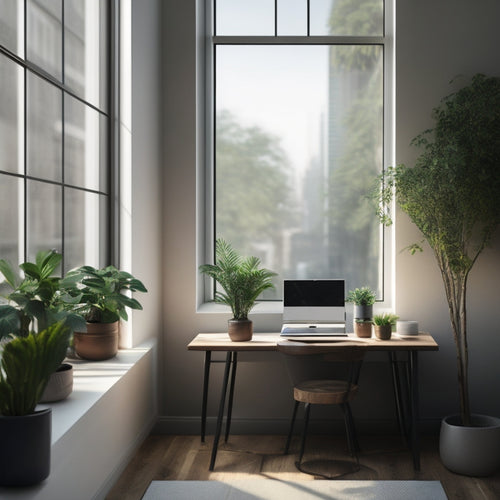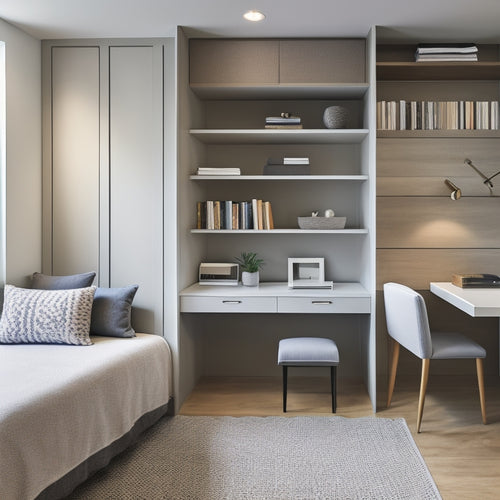
Optimizing Your Small Home Storage: Expert Strategies
Share
You're likely no stranger to the frustration of living in a small home with limited storage space. To optimize your storage, start by evaluating your needs and available space, categorizing items into essentials, seasonals, and occasional use. Next, maximize your vertical space with shelf dividers, wall hooks, and floor-to-ceiling storage. Utilize hidden storage areas like secret shelves and hidden compartments. Rearrange your furniture to maximize corner space and streamline traffic flow. Declutter and purge items you no longer need, and develop habits like making your bed and putting items away after use. By implementing these expert strategies, you'll be well on your way to a more organized, clutter-free living space - and there's even more to explore.
Key Takeaways
• Take inventory of belongings to identify storage needs and available space, and categorize items into essentials, seasonals, and occasional use.
• Utilize vertical and hidden storage by installing shelf dividers, wall hooks, and floor-to-ceiling storage to maximize space.
• Optimize furniture arrangement by maximizing corner space, streamlining traffic flow, and positioning furniture for clear pathways.
• Establish decluttering and purging strategies by sorting items into keep, donate, or discard categories, and scheduling regular decluttering sessions.
• Develop organization habits and routines, including daily tidying, regular maintenance checks, and adopting a tidy mindset to maintain control and order.
Assessing Your Storage Needs
As you prepare to optimize your small home's storage, take inventory of your belongings and identify what you need to store, how often you use each item, and how much space you realistically have available. This pivotal step will help you determine your storage goals and create a space inventory.
Be honest with yourself – what can you let go of, and what must you keep? Categorize items into essentials, seasonals, and occasional uses to prioritize your storage needs.
Next, assess the available storage spaces in your home, including closets, shelves, and cabinets. Measure their dimensions and consider their accessibility. This will help you decide where to store each category of items.
Set specific storage goals, such as freeing up a certain amount of floor space or creating a functional home office. By understanding your storage needs and available space, you'll be able to create a tailored storage plan that meets your unique requirements.
With a clear understanding of your storage goals and space inventory, you'll be well on your way to optimizing your small home's storage.
Maximizing Vertical Space
You can exponentially increase your storage capacity by utilizing your walls and ceiling, creating a sense of openness while keeping essential items within easy reach. By installing shelves, hooks, and other storage solutions, you can make the most of your vertical space and keep your floors and surfaces clutter-free.
Here are three ways to maximize your vertical space:
-
Install shelf dividers: These will help you organize your shelves and keep similar items together, making it easier to find what you need when you need it.
-
Use wall hooks: Hang items like bikes, bags, or accessories from the wall to free up floor space and keep your entryways clear.
-
Opt for floor-to-ceiling storage: Consider installing floor-to-ceiling bookshelves or storage units to make the most of your wall space and keep your belongings organized and out of sight.
Utilizing Hidden Storage Areas
By incorporating hidden storage areas into your small home design, you'll be able to stash away items that you don't use frequently, keeping your living spaces clutter-free and visually appealing. One clever way to do this is by installing secret shelves behind decorative panels or artwork. These secret shelves can hold items like linens, out-of-season clothing, or even important documents.
Another option is to create hidden compartments within furniture pieces, such as a storage ottoman or a coffee table with a lift-top. You can also utilize the space under your stairs by installing pull-out drawers or shelves.
Additionally, consider adding hidden compartments to your walls, like a sliding bookcase or a hidden cabinet. These clever storage solutions will help you keep your belongings organized and out of sight, making your small home feel more spacious and relaxed.
Optimal Furniture Placement
When arranging your furniture, you'll want to make the most of every inch in your small home.
By maximizing corner space and streamlining traffic flow, you'll create a more functional and efficient living area.
Start by identifying the corners and pathways that need the most attention, and then think creatively about how to use furniture to optimize these areas.
Maximize Corner Space
Corner spaces, often considered dead zones, can be transformed into functional areas with strategically placed furniture that hugs the walls, freeing up floor space for other essentials. By doing so, you'll create a more efficient and organized living space.
When it comes to maximizing corner space, consider the following strategies:
-
Install corner shelves: These can be custom-made to fit your specific needs, providing ample storage for books, decorative items, or kitchen utensils.
-
Use corner decor: Add a decorative corner cabinet or a unique corner vase to create visual interest and draw attention to the often-neglected area.
-
Incorporate custom inserts: Design or purchase custom inserts that fit snugly into corner spaces, providing a home for items like cleaning supplies, linens, or office materials.
Streamline Traffic Flow
Now that you've successfully harnessed the potential of corner spaces, turn your attention to the overall layout of your small home. Strategically placing furniture can greatly impact traffic flow and make your space feel more expansive.
To optimize traffic flow, start by identifying the main traffic patterns in your home. Where do you and your family members tend to move through the most? These walking paths will help you determine the best placement for your furniture.
Next, consider the 'work zones' in your home, such as the kitchen and living areas. Position furniture in a way that creates a clear path between these zones, allowing for easy movement. Avoid placing furniture in a way that creates narrow walkways or bottlenecks, as this can make your space feel cramped.
Decluttering and Purging Tips
To maximize storage space in your small home, start by identifying areas where clutter tends to accumulate, such as countertops, shelves, and floors, and then sort items into categories to facilitate decision-making about what to keep, donate, or discard.
As you begin the decluttering process, be aware of emotional attachment to certain items. It's crucial to separate the emotional value from the item's actual usefulness. Ask yourself, 'When was the last time I used this item?' or 'Does it bring me joy?' Be honest, and let go of items that no longer serve a purpose.
To avoid decision fatigue, break down the decluttering process into smaller tasks. Focus on one area or category at a time.
Here are three tips to keep in mind:
-
Handle each item only once: Make a decision about the item as soon as you pick it up to avoid revisiting the same decision multiple times.
-
Keep the 'maybe' box small: Limit the number of items you're unsure about to reduce decision fatigue.
-
Schedule regular decluttering sessions: Set aside time each week to maintain your space and prevent clutter from building up again.
Customizing Storage Solutions
With your decluttered space in hand, you can focus on creating customized storage solutions that cater to your specific needs and maximize the use of every inch. This is where your personal Storage Personality comes into play. Think about your lifestyle, habits, and preferences. Do you need ample shelving for books, or storage bins for toys? Perhaps you require a designated area for your hobbies or workspace. By understanding your Storage Personality, you can design a system that complements your daily routines.
Design Flexibility is key in small home storage. Consider investing in multi-functional furniture pieces or adaptable storage units that can be easily rearranged as your needs change. For example, use stackable containers or shelves that can be adjusted to accommodate different item sizes. You can also repurpose items, like using a vintage ladder as a bookshelf or turning an old trunk into a storage ottoman.
Maintaining Your Organized Space
Now that you've optimized your small home's storage, it's important to maintain your newly organized space.
You'll want to establish daily habits that keep clutter at bay and schedule regular tidy sessions to make sure your space stays organized.
Daily Habits Matter
You establish a routine of putting things back in their designated places after use to maintain the sense of calm and control that comes with an organized space. This habit is important in preventing clutter from building up and keeping your small home storage optimized. By incorporating daily habits into your routine, you'll find it easier to maintain your organized space.
Here are three daily habits to get you started:
-
Morning Routine: Begin your day by making your bed as soon as you get up. This sets the tone for a tidy day and helps create a sense of discipline.
-
Put Away After Use: Make it a habit to put away items like dishes, toys, or cleaning supplies after use. This prevents clutter from accumulating and saves you time in the long run.
-
Nighttime Ritual: End your day by tidying up living areas, wiping down surfaces, and preparing for the next day. This helps you unwind and ensures a smooth morning routine.
Regular Tidy Sessions
Regular tidy sessions serve as a maintenance check for your organized space, ensuring that clutter doesn't creep back in and undo all your hard work. By incorporating regular tidy sessions into your routine, you'll maintain a sense of control and order in your small home.
To make the most of these sessions, adopt a tidy mindset and prioritize tasks based on importance and urgency.
Incorporate tidy sessions into your morning routine, even if it's just 10-15 minutes a day. This could be as simple as putting away dishes, wiping down countertops, or making your bed. Consistency is key, so try to set a specific time and day for your tidy sessions. This will help you stay on track and make it a habit.
Frequently Asked Questions
How Do I Store Items That Don't Fit in My Closet or Shelves?
"Sorry, not sorry, but it's time to admit you're a hoarder if you're wondering what to do with stuff that won't fit in your closet or shelves. Create hidden compartments and utilize vertical spaces to stash your treasures, and breathe a sigh of relief!"
Can I Use Storage Bins in a Humid or Damp Environment?
When using storage bins in humid or damp environments, you'll want to prioritize moisture protection. Opt for bins made from waterproof materials, like plastic or silicone, to guarantee that your items stay dry and protected from moisture damage.
Are There Any Eco-Friendly Storage Solutions Available?
You'll be happy to know that yes, there are eco-friendly storage solutions available! Look for products made from sustainable materials and opt for reusable containers that reduce waste and minimize environmental impact.
How Often Should I Reorganize and Update My Storage Systems?
"As you navigate life's ebb and flow, commit to a seasonal purge, where you reassess and refine your storage systems, fostering habit formation that keeps your space organized, clutter-free, and constantly adapting to your evolving needs."
Can I Use Storage Solutions in a Rental Property or Apartment?
You can use storage solutions in a rental property, but check your lease for renter restrictions and lease limitations first, ensuring you're allowed to make changes or install shelves, hooks, or other organizational systems.
Related Posts
-

Transform Your Space: 5 Online Courses to Help
Ready to transform your space from cluttered to calm? Start with mastering home organization fundamentals, like declu...
-

10 Best Space-Saving Hacks for Tiny Guest Rooms
You're about to transform your tiny guest room into a cozy retreat that's both functional and aesthetically pleasing....

